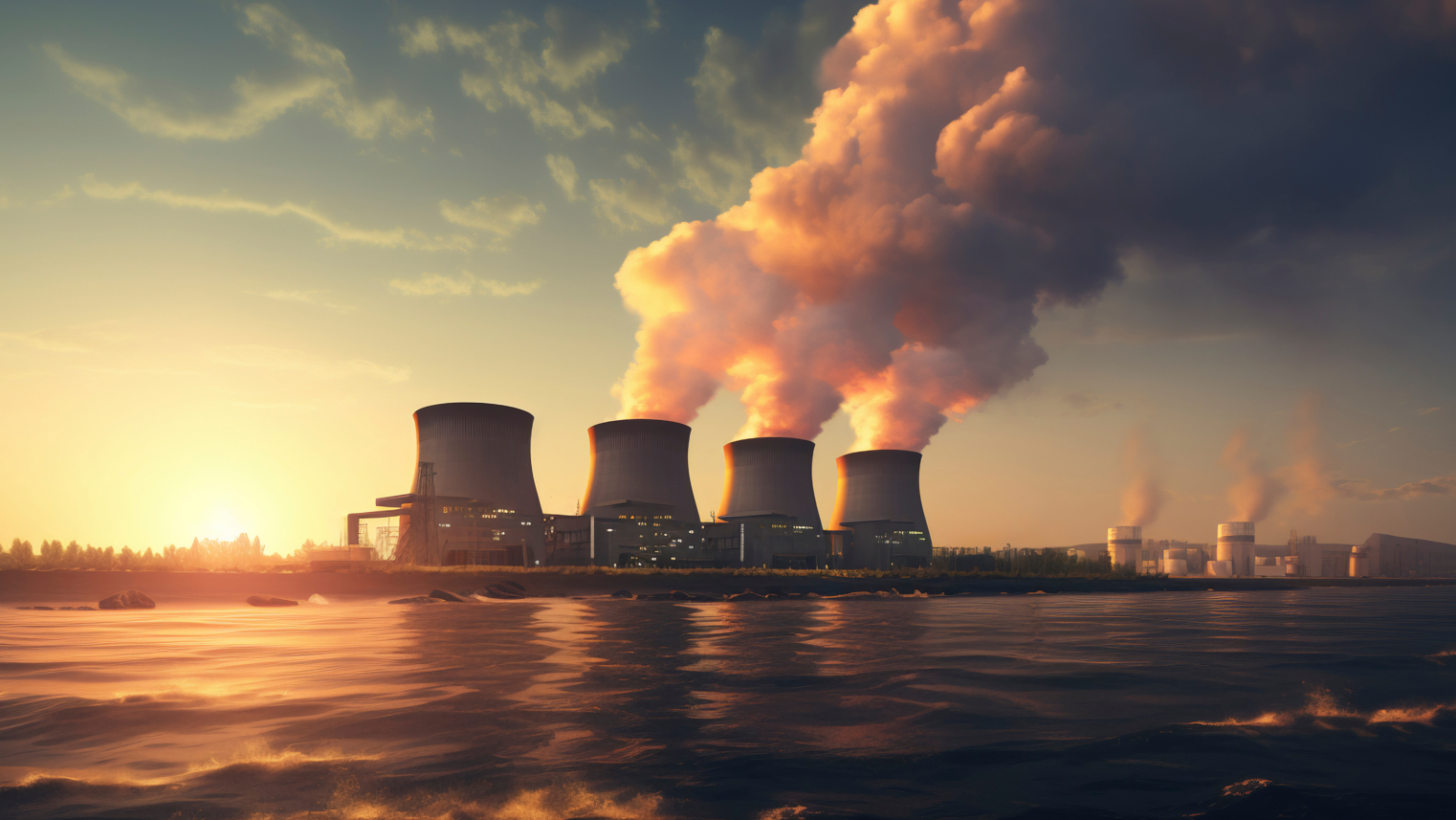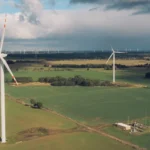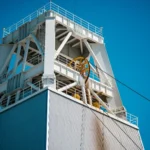„Dropping the nuclear investment in Pątnów goes against Poland’s interests. [ … ] Konin and entire eastern Wielkopolska will have to pay a salty price for the extreme indolence of the government, as the region is waiting for the inevitable collapse after the lignite deposits there are exhausted and the power plant that uses this fuel ceases to operate. Only a large investment, such as a nuclear power plant, can prevent this,” writes Jerzy Lipka, president of the Civic Movement for Nuclear Energy.
- The nuclear power plant, which, by the decision of the previous government (that issued a decision-in-principle), was to be built in the area of Konin, and specifically in Pątnów, would give Poland 22 TWh of electricity.
- Gas fired power plants are a lot better for replenishing solar and wind power as they are more flexible. The problem is that Poland does not have gas, and it has to import 80% of it.
- This means the country has to build a completely new energy system. However, as the government’s decisions reveal, it wants to follow in Germany’s path or close to it, Jerzy Lipka stresses.
The nuclear power plant, which, by the decision of the previous government (that issued a decision-in-principle), was to be built in the area of Konin, and specifically in Pątnów, would give Poland 22 TWh of electricity. It is priceless at a time when the dispatchable capacity in our system is chronically lacking. According to various forecasts, we will run out of 6 to even 13 GW of capacity in the middle of the next decade. This is because a large portion of the coal blocks working today, especially the oldest ones, will have to be permanently decommissioned. It’s not just because they don’t meet emissions standards. They will simply reach the end of their durability.
As many as 70 percent of our current coal-or lignite-burning units are over the age of 40. This is roughly the period they were designed for. In addition, the coal-fired power plants very badly tolerate cooperation with the increasing number of unstable and uncontrollable wind and solar sources in our system. Coal-based energy was designed to operate as the backbone of the energy system and is not suitable for frequent power fluctuations, either up or down. These blocks are increasingly failing precisely because of this.
Gas fired power plants are a lot better for replenishing solar and wind power as they are more flexible. The problem is that Poland does not have gas, and it has to import 80% of it. It is true that several gas units of different sizes are being built at the moment, in Stalowa Wola, West Pomerania and other areas, but comparing their combined capacity with what will soon drop out of our system, it seems definitely not enough. It is estimated that a gas power plan with a capacity of 1 GW working all year will burn up to more than a billion cubic meters of this raw material. Let me remind you that the entire Polish consumption of natural gas today is about 20 billion cubic meters. Of this, only 4 billion come from Poland’s own resources. Moreover, gas-fired power and heating will soon also be censored in the EU, which means that banks will not want to lend to investments of this type, as is happening today with investments involving the burning of coal. This raises significant doubts about the gas strategy.
Gas-fired power plants, although cheap to build, have high variable costs, dependent to a very large extent on fuel prices (dependence in 70 percent). A single gas unit emits about 0.4 tonnes of CO2 per MWh of electricity, which means additional costs for this emission. And gas prices in Poland are now rising, along with energy prices. Similarly, the cost of CO2 emissions will increase, to as much as 200-300 euros for each ton of CO2 emitted in the next decade, according to estimates. These price increases will have to be passed on to consumers. No one in their right mind will invest in gas units that will need to be shut down after 10–15 years of operation. They simply will not pay off.
This means the country has to build a completely new energy system. However, as the government’s decisions reveal, it wants to follow in Germany’s path or close to it (with a marginal share of nuclear energy, if at all). However, this is a road to nowhere, as the example of our western neighbors shows, and no propaganda is able to break the technical realities (a system based on unstable sources cannot function without cheap and efficient energy storage, and this does not exist yet). The simplest example is an energy storage with a capacity of only 100 kWh, the cost of which is well over 100 thousand zlotys. And the number of charge and discharge cycles is 6,000 – 8,000, so it’s enough for about 10 years. No wonder, then, that energy in Germany, especially the unsubsidized one, is becoming more expensive for individual consumers at an alarming rate, already reaching 49 euros/MWh. The EU average is at about 32 euro / kWh. This has its consequences and the industry is moving from Germany to countries with lower energy prices.
In addition, Germany is not able, after the shutdown of all nuclear power plants, to move away from fossil fuels, lignite, and mainly natural gas, because it would quickly run out of energy. It will stay dependant on these for a long time in spite of the propaganda and declarations made by its political class.
The second way to build a new energy sector is to develop nuclear energy that will replace coal-fired units both in professional and industrial power industry as well as in heating. Nuclear units can cooperate with the unstable renewables, but this is not advisable for economic reasons. Once built, nuclear power plants should work as many hours a year as possible to repay the loan. Here, in contrast to gas power plants, we are dealing with high investment costs and cheap operation, using a minimum amount of raw material. These investment costs depend to a large extent on the interest rate on the capital needed for construction, but here there is a positive change in the EU itself, thanks to France and its allies other countries developing or planning to develop the atom. This will soon open up the possibility of obtaining cheaper loans for construction from banks, also in Europe.
So far, two large nuclear power plants have been planned in Poland, namely Choczewo in Pomerania, which will have three Westinghouse units, with a total of 3.75 GW of cpacity and 30 TWh of electricity per year (Polish Nuclear Power Plants are responsible), and two Pątnów units with a total of 2.8 GW, built by PGE-PAK Nuclear Energy. The technology was to be provided by the Korean KHNP. The power plant was to be constructed outside of the government-led Polish Nuclear Power Program Program (PPEJ). However, the government has influence over the project through the state-owned company PGE. This could generate 22 TWh of electricity annually, meaning both power plants together would cover a quarter of Poland’s demand, and with the addition of SMRs, even a third. The latter, mainly BWRX-300 (300 MW) water-boiling, and Rols-Roys, water-pressure (470 MW), would be used mainly to cover the needs of large industrial plants, and in the heating industry, such as powering the Warsaw heating network, the largest in Europe. Today it is mainly powered by coal and gas.
The situation in our energy sector demands maximum acceleration in the implementation of nuclear energy, and on a large scale. On top of that we have to simplify procedures before the construction starts. However, the government is going in the opposite direction, delaying and limiting investment in the atom, seeming to believe uncritically in the myth that RES is supposed to fix everything. Well, it won’t.
It may not be a matter of faith, but following someone else’s instructions, whether it be from a foreign country or from internal lobby groups, it doesn’t really matter. The effect is the same in each case. Trying to justify this type of decision does not make sense, and writing that „the government wants to exchange the Koreans for the French” or „the Koreans are in a dispute with the US, so Poland can not bet on their technology”, in my opinion, is a smoke screen, nothing more. It’s just an attempt to cover up the essentially anti-Polish decision by supporters of the current government, who for some reason are not opponents of nuclear power. They simply feel stupid and do not know how to explain the decisions of their leaders with whom they most probably do not agree deep down, they don’t even believe in what they are writing.
If it was really about the French, then they could always be given a third location (the second within the PPEJ), for example in Belchatow, and as for the KHNP-Westinghouse dispute, the US Court in the first instance decided the Koreans were right and changed the American technology so much that it has become their intellectual property. We don’t know what will happen in the second court instance, but there is a possibility of an amicable settlement of the dispute, as the Koreans are to provide turbines for Westinghouse reactors. Importantly, the Czechs who are pragmatic by nature, did not exclude KHNP from their tender for the construction of new atomic units. That says a lot. They seem not to care about the US-Korea dispute, pursuing their interests above all else.
The Korean concern KHNP builds quickly and efficiently, within the established budget. An example of this is the completed investment in the United Arab Emirates in Barakah. Completed within just 12 years from the groundbreaking, four APR 1400 units totaling 5,600 MW, equivalent to our Bełchatów plant.
The European version of the APR 1400 differs mainly in that the reactor safety dome has double concrete walls rather than single ones. This does not seem to be a significant problem for an efficient and experienced company. The two Polish APR 1400 reactors were estimated by the Koreans at approx. $ 10-11 billion. That’s less than Westinghouse’s estimated cost of $ 7 billion a reactor. In the case of Koreans, there is a chance to transfer reactor technology to Poland. And develop our own designs of this type in the future.
People appointed to leadership positions by the current government seem to be betting everything on one card, disregarding the fact that such an approach could lead to losing everything as well. Because risks are not managed appropriately in this manner. And above all, the economic future of the country can be lost if there is no significant progress in energy storage and its costs over the next few years. There is no guarantee of success here. PGE, for example, announced the suspension of the NPP project in Pątnów, and focused on offshore wind farms. However, the Swedish example, where there are already more than 14 GW in wind turbines, their measured efficiency varies annually between 26 and 33 percent. But what about the rest of the time? The Baltic is not the North Sea, and certainly not the Atlantic, where the annual capacity factor of these devices is significantly higher-Denmark, Germany, Great Britain or Ireland. For comparison, the annual capacity factor at a nuclear power plant is about 88-92 percent (once every year and a half there is a break for a partial fuel change, in the case of Westinghouse it lasts approx. 28 days).
The Civic Movement for Nuclear Energy will soon be arrive in Konin. Our goal is to gauge public sentiment in order to organize resistance against harmful government decisions regarding Pątnów. We are going to meet with residents, local governments, also trade unions. Konin and entire eastern Wielkopolska will have to pay a salty price for the extreme indolence of the government, as the region is waiting for the inevitable collapse after the lignite deposits there are exhausted and the power plant that uses this fuel ceases to operate. Only a large-scale investment can save us from this, such as a nuclear power plant, which would preserve a significant portion of jobs—albeit through retraining—and create new opportunities and perspectives. When there is no investment, there is simply no future in Konin and this must be clearly stated.
The leaders of the Civic Platform, I think, are using the salami method, i.e. the gradual curtailment of the nuclear program, without publicly announcing its end, since the majority of the public, including their supporters, supports the construction of the NPP in Poland, and especially this support is large in the Konin region, where there aren’t even any local committees opposed to this investment. The Civic Platform thus seems to confirm all the worst opinions about it, expressed in election campaigns by its political competitors, and in eastern Wielkopolska, where it has performed well so far, one should expect a massive change in public attitude towards this party, as anti-development, acting to the detriment of the region and the country.
At yesterday’s press conference in the Sejm, three organizations supporting atom, i.e. the Civic Movement for Nuclear Energy, the Association for a Nuclear Power Plant in Pomerania, and the TAK Committee for Atom in the Choczewo Commune announced the start of actions aimed at changing the attitude of the government. In particular, the decision on Pątnów. We will begin with milder pressure, like writing letters to collect signatures, but gradually escalating the protest, if this does not work, we will organize a march to the Prime Minister’s Chancellery after the summer holidays. The latter, however, requires preparation to ensure attendance. We need to gain support from other communities, especially those that were defending the CPK project, a-political people who are for developing our country.
The letters will also be addressed separately to the two coalition partners in the government, i.e. the Third Way and the Left, so that they can take firm positions. Without them, the government cannot continue. It is also a unique opportunity for them to restore public confidence after they completely lost the EP election. Moreover, the current Climate Minister comes from the Konin region, and I wonder what she has to say to her voters in a region threatened by a large-scale economic and social disaster? Because the fact that the investment is not pursued by the government is no excuse. After all, PGE is a state-owned company, where politicians have a decisive influence. We are also curious about the reaction of PAK and Mr. Zygmunt Solorz, for whom PGE turned out to be an incredible partner. Moreover, this situation also calls into question Poland’s credibility as a partner in large investments, where any new government can do a 180 and where there is no continuity, and the desire to bring down a political opponent outweighs the raison d’etat for the state of the country. And this is happening because as a society, we allowed immature politicians who are unfit to govern the country to take the helm.
However, the effectiveness of the actions of OREJ and our allies will depend on the degree of social activity and the degree of support for our actions by the average Pole. Without this, it would be difficult to think about changing the attitude of the government. However, the example of CPK shows that success can be achieved.









